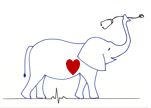Cardiomyopathy Quiz
1. In cats with hypertrophic cardiomyopathy and left ventricular outflow tract obstruction, which of the following drugs is usually avoided?
a. Pimobendan
b. Furosemide
c. Clopidogrel
d. Enalapril
Answer
2. In cats with hypertrophic cardiomyopathy and congestive heart failure, which of the following 3 drugs are typically used?
a. Pimobendan, furosemide, and aspirin
b. Furosemide, and ACE inhibitor, and clopidogrel
c. Furosemide, spironolactone, and amiodarone
d. Diltiazem, atenolol, and furosemide
Answer
3. Which 2 diseases should be excluded in cats with LV hypertrophy who are over 6-7 years of age?
a. Systemic hypertension and hyperthyroidism
b. Hyperthyroidism and diabetes mellitus
c. Diabetes mellitus and renal disease
Answer
4. An antithrombotic drug might be started in:
a. All cats with CHF
b. Cats with moderate to marked left atrial enlargement
c. Cats with an NT-proBNP > 500pmol/L
d. All of the above
Answer
5. Cats with HCM and CHF may have an S4 gallop. An S4 gallop results from:
a. Atrial premature depolarizations
b. Pulmonary hypertension
c. Atrial fibrillation
d. Atrial contraction into a stiff left ventricle
Answer
6. Which drug might be used to limit the adverse effects of left ventricular outflow obstruction in cats with HCM?
a. Atenolol or carvedilol
b. Enalapril or lisinopril
c. Pimobendan
d. Dobutamine
Answer
7. In dogs with dilated cardiomyopathy, an S3 gallop might be noted. This sound is due to:
a. A leak at the mitral valve
b. Mitral valve prolapse
c. Oscillation of the heart at the end of rapid ventricular filling
d. An atrial premature depolarization
Answer
8. Doberman pinschers often have a long asymptomatic period and this phase is often referred to as:
a. Occult cardiomyopathy
b. Obliterative cardiomyopathy
c. Arrhythmogenic Phase
Answer
9. Dilated cardiomyopathy with congestive heart failure if often associated with:
a. Systolic dysfunction
b. Diastolic dysfunction
c. Both
Answer1
10. Serious ventricular arrhythmias in a Boxer dog should trigger concern for a diagnosis of:
a. Arrhythmogenic right ventricular cardiomyopathy
b. Arrhythmogenic left ventricular cardiomyopathy
c. Hemangiosarcoma
d. Pulmonary neoplasia Answer
11. Standard therapy for CHF in dogs with dilated cardiomyopathy usually includes:
a. Pimobendan, spironolactone, and thyroxine
b. Pimobendan, ACE inhibitor, and a diuretic
c. An ACE inhibitor, diuretic, and a calcium channel blocker
d. A diuretic, a calcium channel blocker, and thyroxine
Answer
12. An NT-proBNP concentration > 600 pmol/L in an otherwise healthy Doberman pinscher might trigger a decision to:
a. Pcommend echocardiography to look for occult cardiomyopathy
b. Recommend echocardiography to look for obliterative cardiomyopathy
c. Recommend a urinalysis to look for proteinuria
d. Recommend a thyroid test to search for hyperthyroidism
Answer
13. SAM of the mitral valve refers to:
a. Sympathetic Augmented Magnification – the valve gets smaller following epinephrine release
b. Systolic Anterior Motion – the valve moves toward the interventricular septum in systole
c. SAM Liu, the person who first described this abnormality of the mitral valve
Answer
